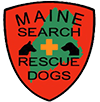It takes a better than average dog to do search and rescue work. While more depends on the individual personality and physical structure of the dog than on its breed, there are certain requirements that cannot be compromised to produce an effective working team. These are:
- The dog must be stable and confident in temperament, willing to approach and play with strangers.
- The dog must be environmentally stable, unafraid of loud sounds and new situations.
- The dog must be confident around, and, in general, not show aggression towards other dogs or animals. SAR dogs work off lead around other SAR dogs and are transported in close quarters together.
- The dog must be able to physically work for a minimum of 8 hours at a time. This work takes place in a woods environment and involves walking, running, jumping and climbing. Working in commercial forests usually means climbing over slash piles of tree limbs and downed trees. Other obstacles are thick brush, rocks and steep terrain. This means that the dog must be the equivalent of an endurance runner, not a weight lifter. For this reason, dogs over 90 pounds are generally not recommended for air scent SAR work. While tracking dogs working on lead might be larger than 90 pounds, the smaller and more agile dogs still have more stamina.
- The dog must be able to be motivated to work for the handler finding human scent. This is a vital element of the dog’s temperament. Many dogs fit the physical requirements but don’t have the ability to be motivated to overcome distractions and the physical challenges of working in rough terrain for long periods of time. Conversely, a large dog may make up for the decrease in agility and stamina by having great desire to work. Preferably, the dog should show a strong desire to play with toys and retrieve and have strong food drive – the desire to take food or treats at any time in any place.
- It takes a minimum of a year and more often two years to train a SAR dog and complete certification testing. Most SAR dogs are retired from the harder search problems by the time they are 8 or 9 years old. Therefore, it does not make sense to start training with a dog older than three years unless the dog has had previous training and, as a minimum, a good working relationship with their handler and basic obedience training. The best age to start a SAR dog is as a puppy, with the caveat that the dog should have hip x-rays and be screened for orthopedic problems when it is old enough, usually about six months.
Different dog breeds were developed for different purposes. The best approach to buying a puppy or young dog for SAR work is to pick a breed that was originally bred to work cooperatively with their handler and then consult with or visit breeders that work their own stock in the areas the dogs were bred to work in. Note that most breeds were bred to work, but not necessarily in cooperation with people. The best breeds for off lead SAR work are the herding, sporting and working breeds. Hounds are good for on- lead tracking work, but, in general, hunt too independently for work off lead. Many of the pointing dog breeds have great energy and physical ability, but many individuals are independent and want to hunt game more than humans. Pointing dogs have to be evaluated on an individual basis and raised to be SAR dogs rather than bird dogs to be effective. Retrievers are hunting dogs but work cooperatively with their handlers and excel in SAR work.
Simply buying a puppy or dog from one of the herding, sporting, or working dog groups does not insure success, because the vast majority of dog breeders today do not work their breeding stock, so they do not know what abilities the dogs may have, nor do they know how to pick good working candidates. The best way to find a dog for SAR work is to visit or consult with people or breeders who participate in dog sports or work the dogs they are breeding from. These dogs are not the dogs that win the AKC dog shows, because the dogs that win the shows are picked for their physical conformation, not for their working ability. Working ability is lost within a generation or two if the breeder does not select for working ability.
Even within a litter born of working parents, puppies will differ in ability and characteristics, just as children differ. Knowing how to test or pick the right puppy or candidate is essential to success. Besides screening for physical problems (the parents if a puppy), the candidate can be tested to the criteria above by taking the puppy or young dog to a new environment and seeing how it reacts. If the candidate shows confidence, further testing can be done with distant gunshots or other loud noises and the approach of a stranger. If the dog accepts these things in stride, the tester should throw a toy and see if the dog chases it, picks it up or otherwise shows intense interest in it. Young puppies have poor eyesight and physical limitations, so having someone who is experienced in testing puppies of the breed you are testing is essential. For young dogs being screened at shelter, if the dog shows intense interest in the toy, the tester should throw the toy into a place where the toy is hard to get to and out of sight, like into some thick bushes or behind furniture. The dog that persistently tries to get to the toy in a new environment no matter what is going on probably has good temperament for SAR work. Older dogs can also be taken near other dogs to see if they show inappropriate aggression.
Aggression towards other dogs is often a result of poor socialization and handling by the owner and is common in the herding breeds. If this aggression is based in a basic insecurity on the dog’s part, this insecurity will probably show up in other forms, like sensitivity to new places, people or loud noises. If the aggression is due to poor socialization and handling, it can often be controlled and moderated with training, so the presence of some dog aggression is not always an eliminating factor for a SAR dog candidate.


